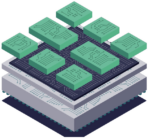Ollie Jones, Vice President of Strategic Sales at Sondrel, has worked extensively across Europe, North America and Asia and has held a variety of commercial leadership roles in FTSE 100, private equity owned and start-up companies.
Most recently Ollie was Chief Commercial Officer for an EV battery start up where he led the acquisition of new customer partnerships with some of the world’s leading car brands.
Prior to that, roles held include VP Commercial and Business Development for a market leading global automotive engineering firm with responsibility for driving the sales growth of its electrification business unit, and VP Customer Business Group where he was responsible for leading multiple large and complex key accounts across Europe and Asia with over $1B cumulative revenues.
I read you have a lot of experience in the automotive industry?
Yes, for the past 20 years I have been working within the automotive industry for such players as Britishvolt, GKN, Williams Advanced Engineering and Prodrive.
Is that why Sondrel has just announced a drive into automotive in the recent press release on Software Defined Vehicles?
Actually, Sondrel has focused on automotive chips for a while now with several successful chips either created or in progress. Just last week, we taped out a custom ASIC for a Tier 1 OEM automotive manufacturer.
It’s a great track record and that was one of the reasons that I joined the company as, with my knowledge and network, I think there is a sizeable opportunity for Sondrel to develop further in the automotive market.
Why should a company come to Sondrel for a solution in the automotive space?
Differentiation has always been key for car manufacturers. With software, electronics and connectivity becoming the major sources of innovation in cars, each car manufacturer is looking to create their own platform of bespoke chips and software that can be scaled to suit all the various models of vehicle in their range. Such a Software Defined Vehicle (SDV) platform will provide cost savings from economies of scale and prevent rivals from copying their innovations as significantly fewer off-the-shelf chips are used.
We have a head start in providing such bespoke platform solutions for customers as we already have our innovative family of Architecting the Future frameworks with the SFA 250A and the SFA 350A that are specially designed for automotive use and are ready for the ISO 26262 compliance process. They have already been successfully used to fast-track automotive projects by up to 30%. These powerful platforms are modularly designed to support scalability based on requirements and to be easily configured with the processing capability and power depending on the end use case and the demands of the customer’s software.
The challenge is that SDV chips will need several processors with billions of transistors to deliver the processing performance to run all the functions such as infotainment, ADAS, vehicle sensing and connectivity. Such ultra-complex custom chips have been our speciality for over two decades.
The key to Sondrel’s success with delivering such ultra-complex chips is that our team works closely with customers at the architectural design stage to ensure that the right balance of power, performance and cost is achieved right from the start. We use the most advanced semiconductor nodes and our turnkey service can take projects all the way from initial architectural design through to the exhaustive testing needed for automotive components to supplying chips. This turnkey service frees the Automotive OEMs and, of course, other customers, from the risks of a multi-stage, multi-supplier, supply chain that have become all too problematic over the past couple of years. By partnering with Sondrel, they can now own their chip destiny and, with our global footprint, we are ideally positioned to deliver it for customers around the world.
Sondrel’s experience in automotive electronics has been developed from many chip projects that built up the company expertise in functional safety (FuSa), ISO 26262 and silicon-level security. The latter is particularly important for SDV cars as the 10- to 15-year lifetime of cars means that updates and patches will have to be implemented without exposing vulnerabilities to hackers so security needs to be integral to the chip design. This has to be right from the start when the chip is being specified and continued through all the stages of the chip design and on into silicon production.
So, that’s why we think that we are the solution provider of choice as we are one of the few companies with the experience and expertise to design such ultra-complex chip projects that fully integrate hardware and software that will be the enablers of SDVs.
Sondrel is known for being a leading design house and now you are extending that to include the supply chain. Why do that?
The industry is changing. The old model of companies, especially systems houses, buying in chips from third parties is being replaced by them wanting to have their own custom chips. This gives them total control of their IP and differentiation. In the process of designing these ultra-complex chips for them we start with the architectural specification stage where we work intimately with the customer to determine exactly what they want to achieve with the chip. This enables us to use our many years of experience to precisely specify the chip in terms of performance, power and area. The classic PPA. Integral to this is our holistic view of the whole supply chain that means that right at this initial stage we consider, for example, the best node to use to deliver the price and performance target required. And then there is the choice of packaging. What testing to do, etc. All of these decisions ripple up and down the supply chain. As we have a complete understanding and viewpoint on all the interactions as a turnkey provider, we can ensure everything dovetails together smoothly. And, should an issue arise, it is solved by us all under one roof. A classic one-stop-shop or, as we say, the buck never leaves the building.
As you can see, the architectural specification stage is the foundation for a successful custom chip project. We are one of the few companies to provide such a service and that is a key differentiator from some of our rivals who seem to often take a design specification from the customer and just get on with it with little if any interaction along the way to a final design. There is no value add in that approach. No opportunity to bring a wealth of skills and experience to the design to enhance and improve it as we do. It also means that we develop a deep relationship of trust with the customer that is a foundation for further engagement as a turnkey supplier.
There are so many horror stories of supply chains where disputes have occurred between the various sub-contractors with each blaming the other for problems at hand over stages. This is why we are seeing more and more demand from customers for a turnkey partner, that can manage all aspects of the value chain from initial concept and architecture, where tough decisions need to be made, all the way through implementation and NPI to managing the supply chain. Plus, Sondrel has very close relationships with the major Foundries and OSATs as well as market-leading design expertise, earned over more than two decades.
What if a company just needs help with a part of the supply chain?
That often happens and, with our large team of highly experienced, senior engineers, we can step in and help wherever needed along the supply chain. We have just done that with one company where the design demands were too much for their team and we helped get them back on schedule. And, in another instance, our team found and fixed a deep-rooted bug that had been in a couple of iterations before we came on board.
Finally, any other hot topics to cover such as exciting new areas for custom chips?
We have hundreds of Arm-based custom chip designs under our belt and recently we became are one of the founding members of Arm® Total Design, an ecosystem that is committed to bringing Arm Neoverse™ CSS-based designs to market. Arm Neoverse CSS features high-end Arm Neoverse cores that are designed for infrastructure and datacentre applications and play to our strength of design and supply of high performance, ultra-complex ASICs that will be crucial for customers wanting to rapidly bring such products to market.
These new high-performance cores will enable us to design next generation chips for demanding, compute intensive applications in automotive, machine vision, AI, security, HPC, and networking. Crucially, we are one of the few partners to offer a full, turnkey service from concept through every stage to final chips, which provides customers with peace of mind that their, bet the farm, multi-million-dollar investment in a new chip project will progress smoothly with every stage being handled by our in-house experts.
Also Read:
Transformative Year for Sondrel
Sondrel Extends ASIC Turnkey Design to Supply Services From Europe to US








